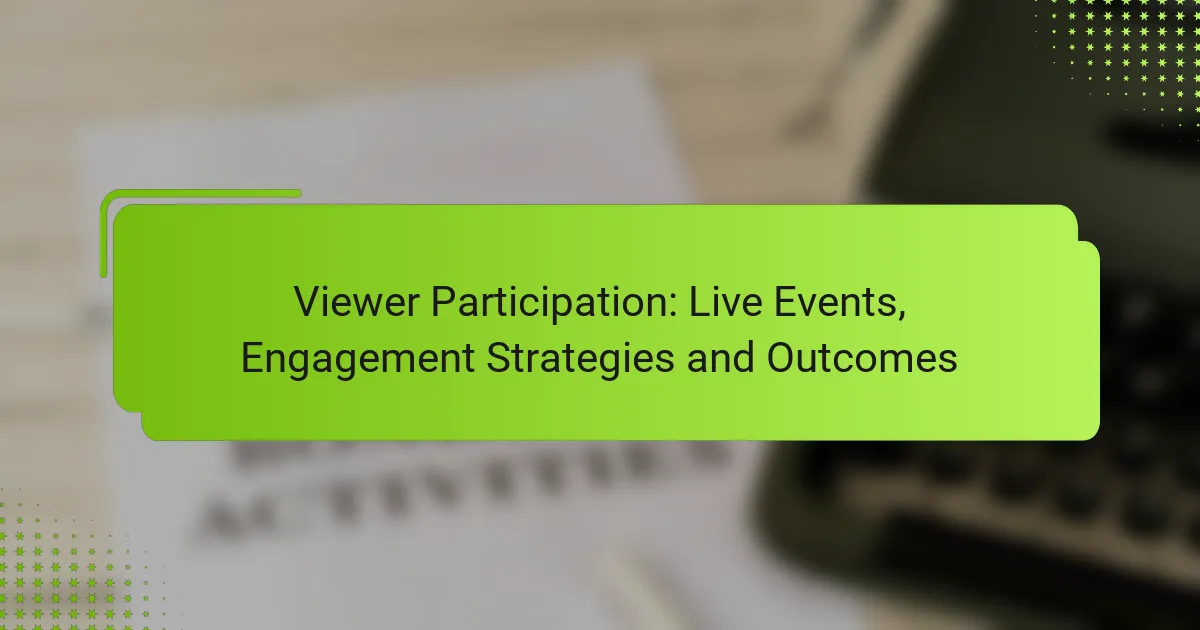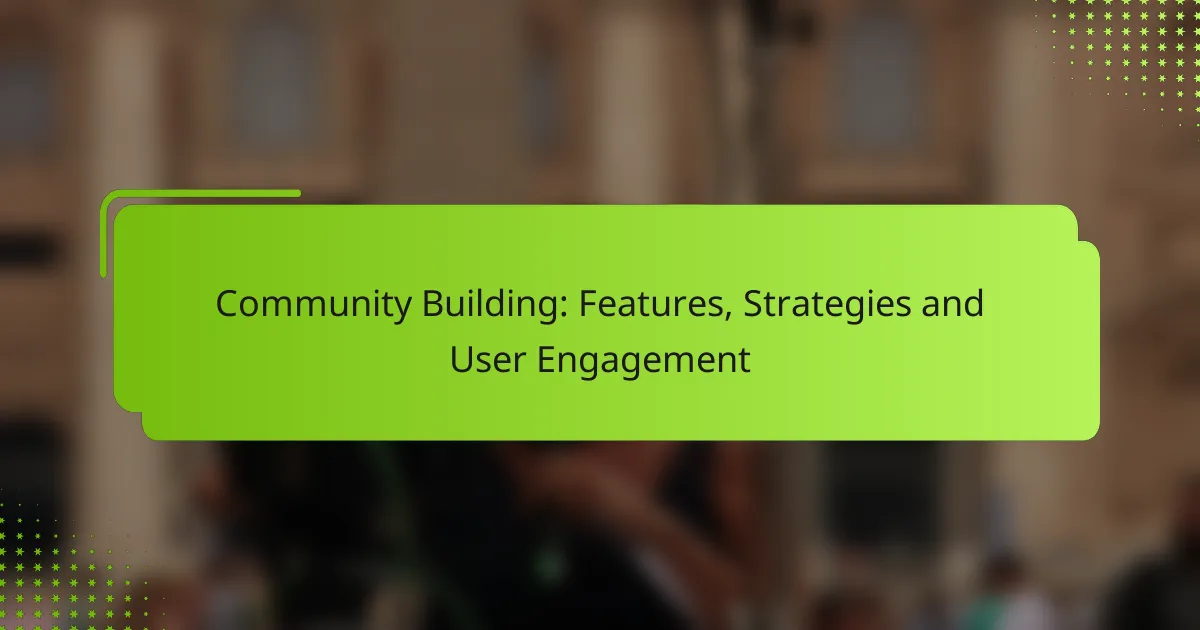Viewer participation plays a crucial role in transforming live events into dynamic and engaging experiences. By incorporating interactive elements and leveraging technology, organizers can foster deeper audience involvement, leading to increased satisfaction and improved outcomes for all participants. Effective engagement strategies not only enhance the event atmosphere but also ensure that attendees feel more connected to the content and creators.

How can viewer participation enhance live events?
Viewer participation can significantly enhance live events by fostering a more interactive and engaging atmosphere. When audiences actively participate, they become more invested in the experience, leading to higher satisfaction and retention rates.
Increased audience engagement
Increased audience engagement occurs when viewers feel they have a stake in the event. This can be achieved through interactive polls, Q&A sessions, or live chats, allowing participants to voice their opinions and ask questions in real-time.
For example, using platforms that allow audience voting on certain aspects of the event can create a sense of involvement. Events that incorporate these features often see engagement rates rise significantly, sometimes by over 50% compared to traditional formats.
Real-time feedback mechanisms
Real-time feedback mechanisms enable organizers to gauge audience reactions instantly. Tools such as live surveys or social media interactions can provide immediate insights into what resonates with viewers.
Implementing these feedback systems allows event planners to adjust content dynamically, enhancing the overall experience. For instance, if a particular segment is receiving negative feedback, organizers can pivot to a different topic or format without losing momentum.
Community building opportunities
Community building opportunities arise when viewers connect with each other during live events. Creating dedicated spaces for discussion, such as forums or social media groups, encourages participants to share experiences and network.
Events that foster community often see long-term benefits, as attendees are more likely to return for future events. Establishing a sense of belonging can lead to increased loyalty and advocacy, turning casual viewers into dedicated fans.

What are effective engagement strategies for live events?
Effective engagement strategies for live events include interactive elements that encourage audience participation and enhance their experience. These strategies can significantly boost audience involvement and satisfaction, leading to better outcomes for both organizers and attendees.
Interactive polls and surveys
Interactive polls and surveys allow attendees to share their opinions in real-time, creating a sense of involvement. These tools can be integrated into event platforms or social media, enabling quick feedback on topics ranging from session content to speaker performance.
To implement this strategy, consider using platforms like Slido or Mentimeter, which facilitate easy setup and participation. Aim to keep polls concise, focusing on 1-3 key questions to maintain engagement without overwhelming the audience.
Social media integration
Integrating social media into live events fosters community engagement and extends the event’s reach. By encouraging attendees to share their experiences using specific hashtags, organizers can create a vibrant online conversation that complements the live experience.
Utilize platforms like Twitter and Instagram for live updates, behind-the-scenes content, and audience shout-outs. Ensure to monitor these channels actively to respond to comments and questions, enhancing the connection with participants.
Gamification techniques
Gamification techniques introduce game-like elements to live events, making participation more enjoyable and competitive. This can include leaderboards, challenges, or rewards for engagement, which motivate attendees to interact more actively.
Consider offering prizes or recognition for top participants to incentivize involvement. Simple actions like awarding points for answering questions or participating in discussions can create a lively atmosphere and encourage attendees to engage more deeply with the event content.

What technologies facilitate viewer participation?
Viewer participation in live events is enhanced through various technologies that enable interaction and engagement. Key tools include live streaming platforms, audience response systems, and virtual reality experiences, each offering unique features to connect audiences with content creators.
Live streaming platforms
Live streaming platforms allow creators to broadcast events in real-time, enabling viewers to engage through comments, reactions, and polls. Popular platforms like YouTube Live, Twitch, and Facebook Live provide built-in chat features that facilitate direct interaction between the audience and the host.
When selecting a platform, consider factors such as audience size, accessibility, and the types of engagement tools available. For example, Twitch is ideal for gaming content, while Facebook Live may be better for community-focused events.
Audience response systems
Audience response systems (ARS) enable real-time feedback from viewers during live events, often using smartphones or dedicated devices. These systems can conduct polls, quizzes, and surveys, allowing hosts to gauge audience sentiment and adjust their content accordingly.
Effective use of ARS can significantly enhance engagement. For instance, incorporating quick polls during a presentation can keep the audience involved and provide valuable insights. Be cautious of overloading viewers with too many questions, as this can lead to disengagement.
Virtual reality experiences
Virtual reality (VR) experiences immerse viewers in a simulated environment, offering a unique way to participate in live events. Platforms like Oculus and HTC Vive provide tools for creating interactive experiences that can transport users to virtual venues, enhancing the sense of presence and engagement.
When implementing VR, consider the technical requirements and accessibility for your audience. Not all viewers may have access to VR headsets, so offering alternative participation methods is crucial. Additionally, ensure that the VR experience is intuitive to avoid overwhelming users with complex controls.

How do engagement strategies impact event outcomes?
Engagement strategies significantly influence event outcomes by enhancing participation and satisfaction among attendees. Effective strategies can lead to higher attendance, better retention of audience interest, and increased opportunities for sponsorships.
Higher attendance rates
Implementing engaging strategies, such as interactive sessions and real-time polls, can attract more attendees to events. For example, offering early-bird discounts or exclusive content can incentivize registrations, leading to attendance rates that exceed initial expectations.
Additionally, promoting events through social media and leveraging user-generated content can create buzz and draw in larger crowds. Consider using targeted ads to reach specific demographics, which can further boost participation.
Improved audience retention
Engagement strategies like gamification and personalized experiences help maintain audience interest throughout the event. For instance, incorporating live Q&A sessions or breakout discussions encourages attendees to stay engaged and participate actively.
To improve retention, ensure that the content is relevant and tailored to the audience’s interests. Regular feedback loops, such as surveys during the event, can also help adjust the program in real-time to keep participants invested.
Increased sponsorship opportunities
Successful engagement strategies can attract sponsors looking for visibility and interaction with a targeted audience. Events that demonstrate high attendance and active participation are more appealing to potential sponsors, as they see value in reaching engaged consumers.
To maximize sponsorship opportunities, showcase engagement metrics and participant demographics to potential sponsors. Offering tiered sponsorship packages that include interactive elements, such as branded activities or sponsored sessions, can further enhance appeal and revenue potential.

What are the best practices for implementing viewer participation?
Effective viewer participation enhances engagement during live events by fostering interaction and feedback. Best practices include clear communication, staff training, and ongoing strategy adjustments to maximize audience involvement.
Clear communication of participation methods
Clearly outlining how viewers can participate is crucial for engagement. Use multiple channels such as social media, event websites, and email to inform the audience about participation options like polls, Q&A sessions, or live chats.
Consider creating a simple guide or infographic that illustrates these methods. This can help ensure that all viewers, regardless of their technical expertise, understand how to engage effectively.
Training staff for engagement
Staff training is essential for facilitating viewer participation. Ensure that team members are well-versed in the tools and platforms being used, as well as in techniques for encouraging audience interaction.
Role-playing scenarios can be beneficial, allowing staff to practice responding to viewer questions or comments in real-time. This preparation can lead to more confident and effective engagement during the event.
Monitoring and adapting strategies
Monitoring participation in real-time allows for immediate adjustments to engagement strategies. Use analytics tools to track viewer interactions and identify which methods are most effective.
Be prepared to adapt your approach based on audience feedback and participation levels. For example, if a particular method is not resonating, consider switching to a different format or increasing incentives for participation.

What metrics measure the success of viewer participation?
Success in viewer participation can be gauged through various metrics that reflect engagement levels, audience satisfaction, and social interaction. Key metrics include engagement rates, audience satisfaction scores, and social media mentions, each providing insights into how effectively viewers are participating in live events.
Engagement rates
Engagement rates measure the level of interaction viewers have with the content during live events. This can include metrics such as likes, shares, comments, and the average watch time. High engagement rates often indicate that the content resonates well with the audience.
To calculate engagement rates, divide the total interactions by the total number of viewers and multiply by 100. For instance, if a live event has 1,000 viewers and receives 200 interactions, the engagement rate would be 20%. Aim for engagement rates above 10% for a healthy level of viewer interaction.
Audience satisfaction scores
Audience satisfaction scores reflect how pleased viewers are with the event experience. This can be measured through post-event surveys, where participants rate their satisfaction on a scale, often from 1 to 10. High satisfaction scores indicate that the event met or exceeded viewer expectations.
Consider using a simple survey with questions about content quality, presentation style, and overall experience. Aiming for an average score of 8 or higher is a good benchmark for success. Regularly collecting and analyzing this feedback can help improve future events.
Social media mentions
Social media mentions track how often an event is discussed across various platforms, providing insight into viewer engagement and reach. This includes posts, hashtags, and comments related to the event. Increased mentions can indicate a growing interest and community around the content.
To effectively measure social media mentions, use tools that aggregate data from platforms like Twitter, Facebook, and Instagram. Aiming for a significant increase in mentions compared to previous events can signal successful viewer participation. Engaging with viewers on social media can further enhance this metric.



